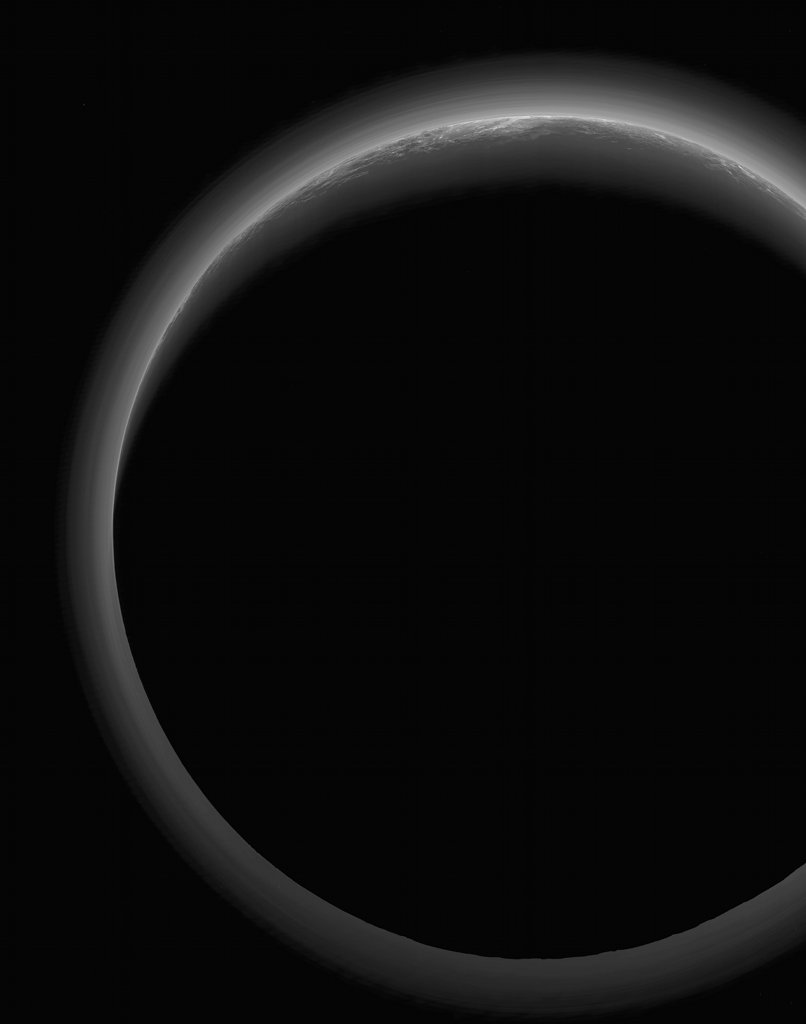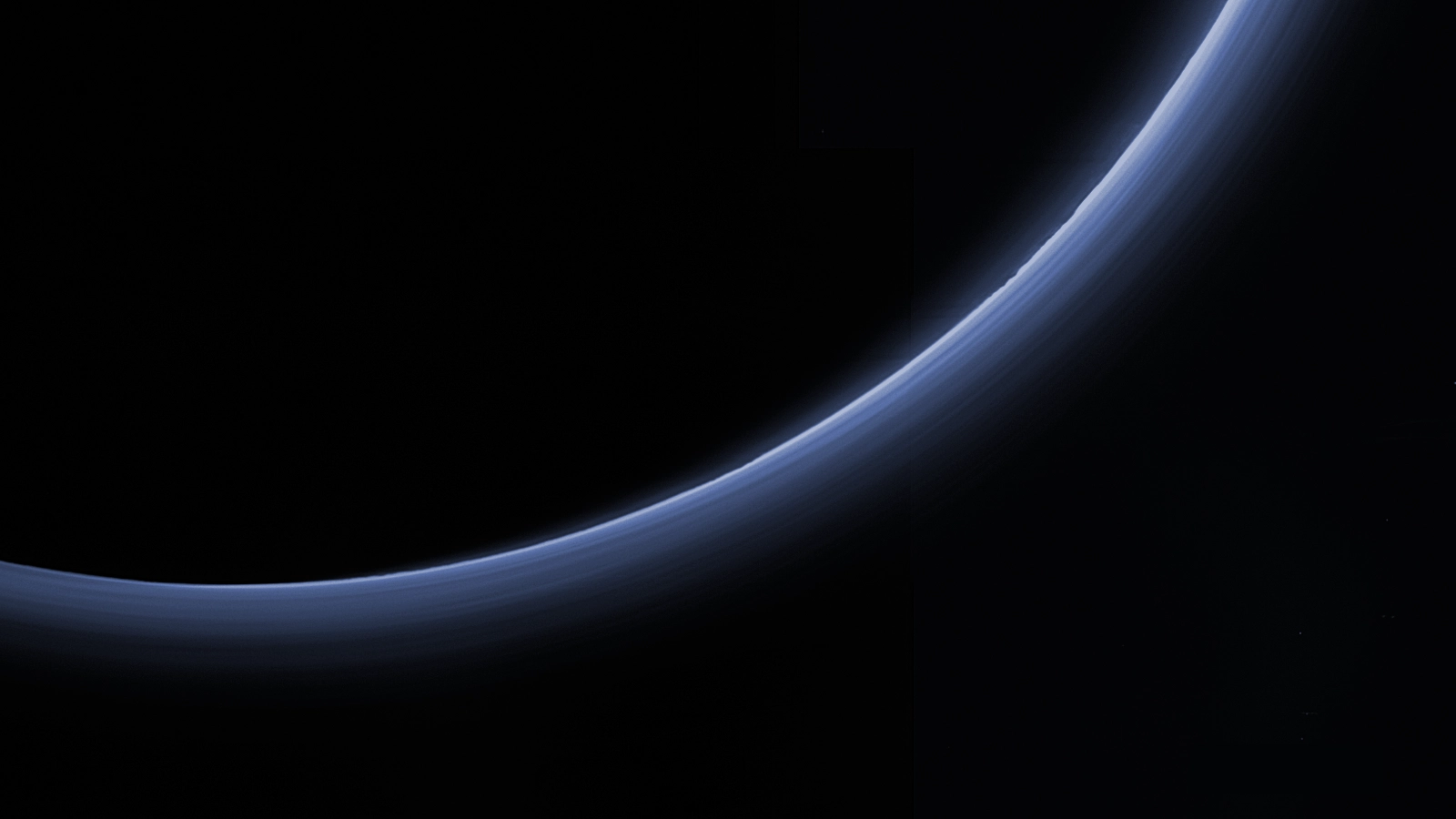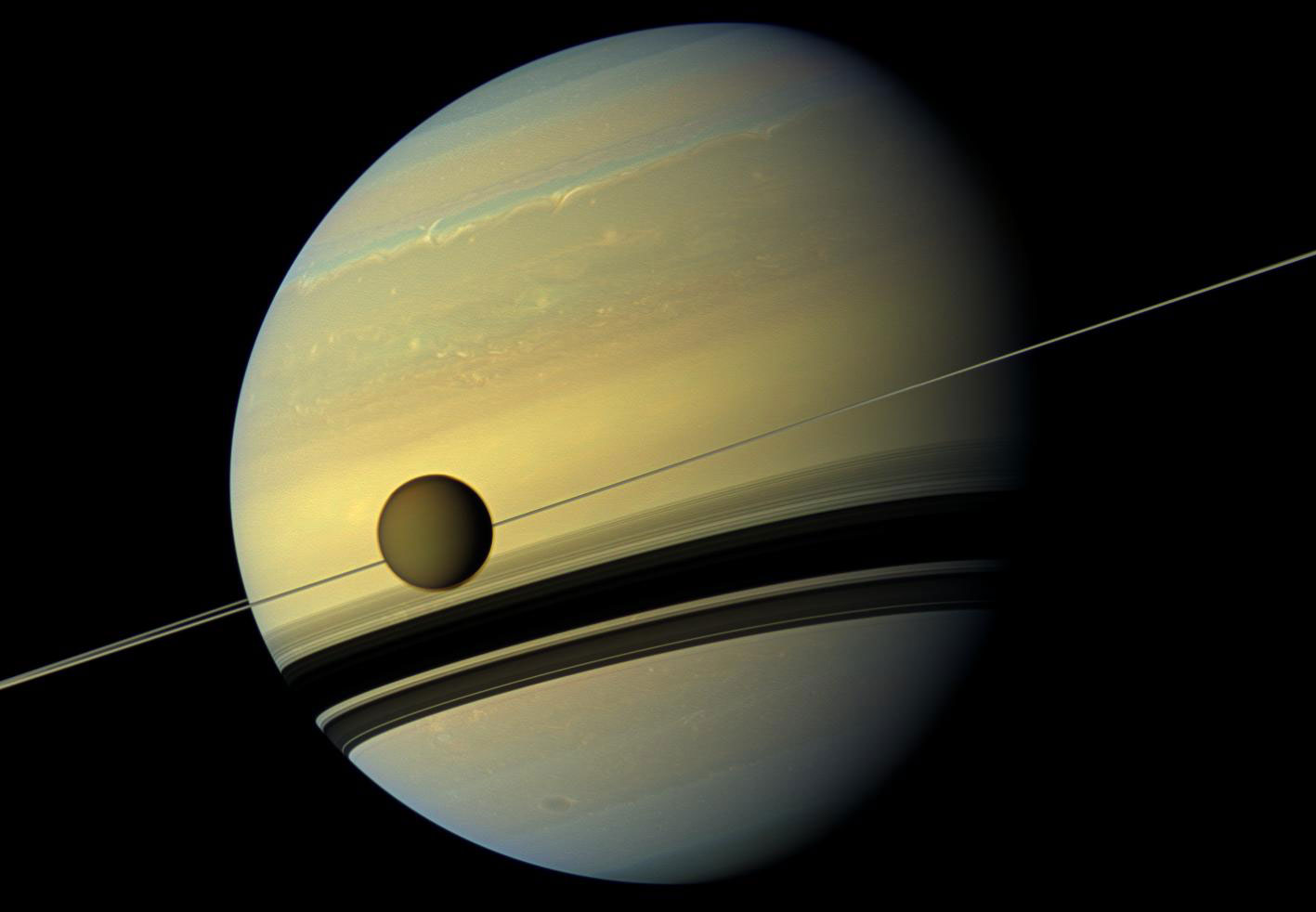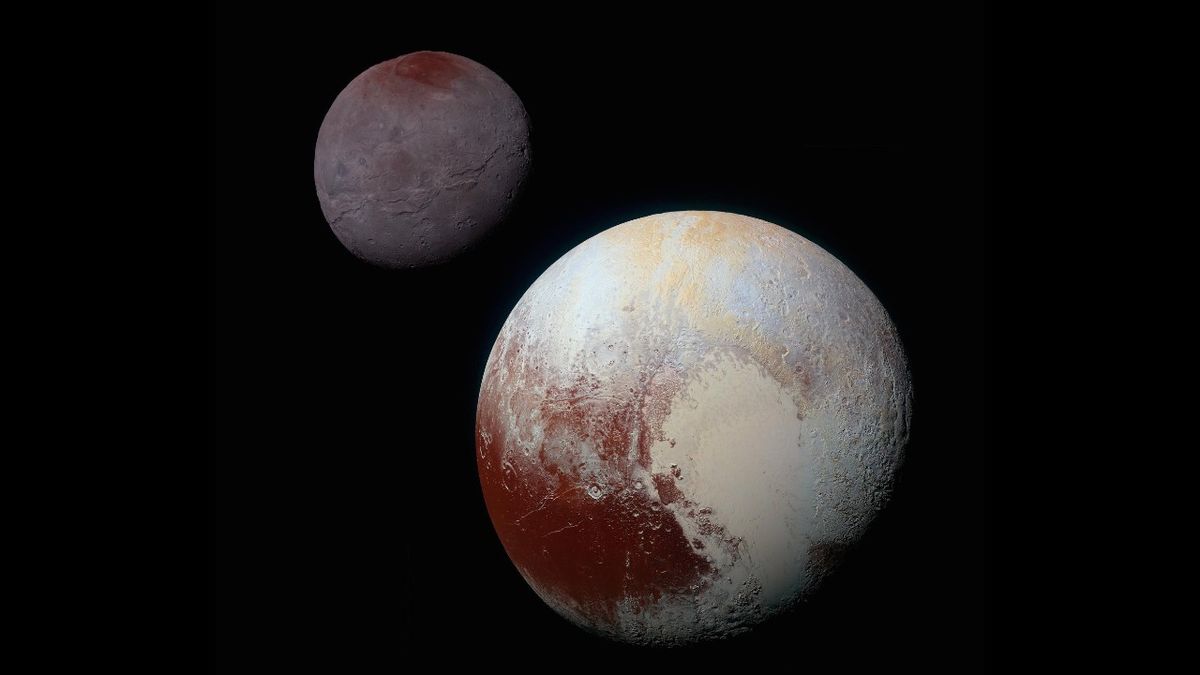Page 1 of 1
APOD: Pluto at Night (2024 Nov 16)
Posted: Sat Nov 16, 2024 5:05 am
by APOD Robot
 Pluto at Night
Explanation:
Pluto at Night
Explanation: The night side of Pluto spans
this shadowy scene. In the stunning spacebased perspective the Sun is 4.9 billion kilometers (almost 4.5 light-hours) behind the dim and distant world. It was captured by far flung
New Horizons in July of 2015 when the spacecraft was at a range of some 21,000 kilometers from Pluto, about 19 minutes after its closest approach. A denizen
of the Kuiper Belt in dramatic silhouette, the image also reveals Pluto's tenuous, surprisingly
complex layers of hazy atmosphere. Near the top of the frame the crescent
twilight landscape includes southern areas of nitrogen ice plains now formally known as
Sputnik Planitia and
rugged mountains of water-ice in the Norgay Montes.
Re: APOD: Pluto at Night (2024 Nov 16)
Posted: Sat Nov 16, 2024 5:43 am
by RocketRon
Pluto -
'Discovered' (by Earthlings) in 1930
Imaged from the far side in 2015.
Technology has come a very long way in those intervening years....
Nitrogen freezing point −210 °C (−346 °F; 63 K)
Brrrrr !!!
Ski fields only for the very well rugged up.
And prepared to travel.
Interesting atmosphere.
And that it is visible in such an image ?
Re: APOD: Pluto at Night (2024 Nov 16)
Posted: Sat Nov 16, 2024 6:38 am
by Ann
The great thing about today's APOD is that it actually shows us some surface details on Pluto below the little planet's layered atmosphere.
A gorgeous high-resolution image really shows surface details of Pluto below the hazy atmosphere, including Sputnik Planitia, the large light-colored "heart" of Pluto:
Doesn't it look amazing?


Talking of Pluto's Sputnik Planitia, we've really got to look at the day side of Pluto, to see its huge nitrogen flood plain heart!
But since I am the Color Commentator - or, more precisely, since I call myself the Color Commentator - I feel compelled to show you that Pluto's atmosphere is blue!
Since Wikipedia compared the atmosphere of Pluto with the upper haze layer of Titan, let's look at the atmosphere of Titan:
Titan is, of course, the largest moon of Saturn. Titan is surprisingly dark compared with the haze-covered yellow cloudtops of Saturn. Titan's blue haze layers are invisible when the moon is seen in front of the face of Saturn. But we do see hints of a blue haze layer on Saturn:
But since the APOD is about Pluto, not about Titan or Saturn, let's look at a picture of Pluto and its (comparatively) huge moon, Charon, to appreciate the brightness or rather reflectivity (albedo) difference between them!
I note that one thing the the Earth, Pluto and Titan have in common is that our atmospheres are mostly composed of nitrogen. All in all, I'm happy that I get to breathe the atmosphere of the Earth rather than the atmosphere of Pluto or Titan!
Ann
P.S. I've got to show you this!
Can you believe it? This picture was taken from the ISS by astronaut Matthew Dominick. You can see the thin crescent of the Moon above the Earth's atmosphere, and our planet's upper atmosphere is rippling with noctilucent clouds. Doesn't it look amazing?
Re: APOD: Pluto at Night (2024 Nov 16)
Posted: Sat Nov 16, 2024 2:29 pm
by Christian G.
What I like about this image of Pluto and Charon which Ann posted is to think that these two are
mutually tidally locked in their slow dance, forever facing one another, never turning their backs. Almost romantic! (although Pluto hides its heart...)
Re: APOD: Pluto at Night (2024 Nov 16)
Posted: Sat Nov 16, 2024 4:56 pm
by Jim Armstrong
A literally awesome APOD, so much to think about.
One of the best ever.
Thanks.
Re: APOD: Pluto at Night (2024 Nov 16)
Posted: Sat Nov 16, 2024 6:25 pm
by JimT
Clarfication, just for the record:
Tenzing Montes
Feature type Mountain range
Location Western Sputnik Planitia, Pluto
Discoverer New Horizons
Eponym Tenzing Norgay
"The Tenzing Montes /ˈtɛnzɪŋ ˈmɒntiːz/ (formerly Norgay Montes) are a range of icy mountains on Pluto, bordering the southwest region of Sputnik Planitia and the nearby Hillary Montes...
The mountains, first viewed by the New Horizons spacecraft on 14 July 2015, and announced by NASA on 15 July 2015, are named after the Nepalese mountaineer Tenzing Norgay...The mountains were informally called Norgay Montes by the New Horizons team, but that name was later changed from Norgay to Tenzing. On 7 September 2017..."
— Wikipedia
Re: APOD: Pluto at Night (2024 Nov 16)
Posted: Sat Nov 16, 2024 6:33 pm
by JimT
JimT wrote: ↑Sat Nov 16, 2024 6:25 pm
Clarification, just for the record:
Tenzing Montes
Feature type Mountain range
Location Western Sputnik Planitia, Pluto
Discoverer New Horizons
Eponym Tenzing Norgay
"The Tenzing Montes /ˈtɛnzɪŋ ˈmɒntiːz/ (formerly Norgay Montes) are a range of icy mountains on Pluto, bordering the southwest region of Sputnik Planitia and the nearby Hillary Montes...
The mountains, first viewed by the New Horizons spacecraft on 14 July 2015, and announced by NASA on 15 July 2015, are named after the Nepalese mountaineer Tenzing Norgay...The mountains were informally called Norgay Montes by the New Horizons team, but that name was later changed from Norgay to Tenzing. On 7 September 2017..."
— Wikipedia
Astonishing image in any case, especially to one who was a teenager in 1957, and can well remember the excitement when Sputnik I was launched in October of that year.
Re: APOD: Pluto at Night (2024 Nov 16)
Posted: Sat Nov 16, 2024 7:45 pm
by AVAO
JimT wrote: ↑Sat Nov 16, 2024 6:33 pm
JimT wrote: ↑Sat Nov 16, 2024 6:25 pm
Clarification, just for the record:
Tenzing Montes
Feature type Mountain range
Location Western Sputnik Planitia, Pluto
Discoverer New Horizons
Eponym Tenzing Norgay
"The Tenzing Montes /ˈtɛnzɪŋ ˈmɒntiːz/ (formerly Norgay Montes) are a range of icy mountains on Pluto, bordering the southwest region of Sputnik Planitia and the nearby Hillary Montes...
The mountains, first viewed by the New Horizons spacecraft on 14 July 2015, and announced by NASA on 15 July 2015, are named after the Nepalese mountaineer Tenzing Norgay...The mountains were informally called Norgay Montes by the New Horizons team, but that name was later changed from Norgay to Tenzing. On 7 September 2017..."
— Wikipedia
Astonishing image in any case, especially to one who was a teenager in 1957, and can well remember the excitement when Sputnik I was launched in October of that year.
"Reasons Why Pluto Is a Dwarf Planet
Pluto orbits the Sun and meets the second criterion, which is a nearly round shape. However, it has difficulty with the other criteria for planethood.
It resides in the Kuiper Belt, a region of small icy bodies, signifying that it has not cleared its neighborhood of other objects. But, clearing an orbit is about mass and not just about location. Pluto is about two-thirds the size of Earth’s moon, but only one-sixth of its mass. It contains a larger proportion of ice to rock than a typical planet and just doesn’t pull in the debris it encounters on its journey around the Sun.
The other issues concern Pluto’s moon, Charon. Pluto has at least five moons, but Charon is special because it’s about half the size of Pluto. It is so massive that the center of mass (barycenter) of the Pluto-Charon system doesn’t actually reside within Pluto, but in the space between the two bodies. Due to this unique characteristic, some argue that Pluto and Charon are a binary (dwarf) planet system. In other words, Pluto and Charon are essentially satellites of each other. However, the IAU has yet to officially recognize binary dwarf planets as a separate category."
Source: https://sciencenotes.org/is-pluto-a-planet/
Re: APOD: Pluto at Night (2024 Nov 16)
Posted: Sat Nov 16, 2024 7:59 pm
by Chris Peterson
AVAO wrote: ↑Sat Nov 16, 2024 7:45 pm
JimT wrote: ↑Sat Nov 16, 2024 6:33 pm
JimT wrote: ↑Sat Nov 16, 2024 6:25 pm
Clarification, just for the record:
Tenzing Montes
Feature type Mountain range
Location Western Sputnik Planitia, Pluto
Discoverer New Horizons
Eponym Tenzing Norgay
"The Tenzing Montes /ˈtɛnzɪŋ ˈmɒntiːz/ (formerly Norgay Montes) are a range of icy mountains on Pluto, bordering the southwest region of Sputnik Planitia and the nearby Hillary Montes...
The mountains, first viewed by the New Horizons spacecraft on 14 July 2015, and announced by NASA on 15 July 2015, are named after the Nepalese mountaineer Tenzing Norgay...The mountains were informally called Norgay Montes by the New Horizons team, but that name was later changed from Norgay to Tenzing. On 7 September 2017..."
— Wikipedia
Astonishing image in any case, especially to one who was a teenager in 1957, and can well remember the excitement when Sputnik I was launched in October of that year.
"Reasons Why Pluto Is a Dwarf Planet
Pluto orbits the Sun and meets the second criterion, which is a nearly round shape. However, it has difficulty with the other criteria for planethood.
It resides in the Kuiper Belt, a region of small icy bodies, signifying that it has not cleared its neighborhood of other objects. But, clearing an orbit is about mass and not just about location. Pluto is about two-thirds the size of Earth’s moon, but only one-sixth of its mass. It contains a larger proportion of ice to rock than a typical planet and just doesn’t pull in the debris it encounters on its journey around the Sun.
The other issues concern Pluto’s moon, Charon. Pluto has at least five moons, but Charon is special because it’s about half the size of Pluto. It is so massive that the center of mass (barycenter) of the Pluto-Charon system doesn’t actually reside within Pluto, but in the space between the two bodies. Due to this unique characteristic, some argue that Pluto and Charon are a binary (dwarf) planet system. In other words, Pluto and Charon are essentially satellites of each other. However, the IAU has yet to officially recognize binary dwarf planets as a separate category."
Source: https://sciencenotes.org/is-pluto-a-planet/
I consider everything that orbits the Sun to be a planet, and beyond that it's just the class of planet. Pluto is as much a planet as Jupiter. Or an asteroid. The IAU definition doesn't change reality, it's just a usage convention for those who write academic papers.
Re: APOD: Pluto at Night (2024 Nov 16)
Posted: Sat Nov 16, 2024 8:03 pm
by AVAO
Re: APOD: Pluto at Night (2024 Nov 16)
Posted: Sat Nov 16, 2024 8:25 pm
by AVAO
Chris Peterson wrote: ↑Sat Nov 16, 2024 7:59 pm
AVAO wrote: ↑Sat Nov 16, 2024 7:45 pm
JimT wrote: ↑Sat Nov 16, 2024 6:33 pm
Astonishing image in any case, especially to one who was a teenager in 1957, and can well remember the excitement when Sputnik I was launched in October of that year.
"Reasons Why Pluto Is a Dwarf Planet
Pluto orbits the Sun and meets the second criterion, which is a nearly round shape. However, it has difficulty with the other criteria for planethood.
It resides in the Kuiper Belt, a region of small icy bodies, signifying that it has not cleared its neighborhood of other objects. But, clearing an orbit is about mass and not just about location. Pluto is about two-thirds the size of Earth’s moon, but only one-sixth of its mass. It contains a larger proportion of ice to rock than a typical planet and just doesn’t pull in the debris it encounters on its journey around the Sun.
The other issues concern Pluto’s moon, Charon. Pluto has at least five moons, but Charon is special because it’s about half the size of Pluto. It is so massive that the center of mass (barycenter) of the Pluto-Charon system doesn’t actually reside within Pluto, but in the space between the two bodies. Due to this unique characteristic, some argue that Pluto and Charon are a binary (dwarf) planet system. In other words, Pluto and Charon are essentially satellites of each other. However, the IAU has yet to officially recognize binary dwarf planets as a separate category."
Source: https://sciencenotes.org/is-pluto-a-planet/
I consider everything that orbits the Sun to be a planet, and beyond that it's just the class of planet. Pluto is as much a planet as Jupiter. Or an asteroid. The IAU definition doesn't change reality, it's just a usage convention for those who write academic papers.
I agree with you. Rule 3 was only introduced by the IAU so that the number of planets in the solar system remains manageable, i.e. it is, as you say, a pure convention.
Re: APOD: Pluto at Night (2024 Nov 16)
Posted: Sun Nov 17, 2024 4:57 am
by Ann
AVAO wrote: ↑Sat Nov 16, 2024 7:45 pm
"Reasons Why Pluto Is a Dwarf Planet
Pluto orbits the Sun and meets the second criterion, which is a nearly round shape. However, it has difficulty with the other criteria for planethood.
It resides in the Kuiper Belt, a region of small icy bodies, signifying that it has not cleared its neighborhood of other objects. But, clearing an orbit is about mass and not just about location. Pluto is about two-thirds the size of Earth’s moon, but only one-sixth of its mass. It contains a larger proportion of ice to rock than a typical planet and just doesn’t pull in the debris it encounters on its journey around the Sun.
The other issues concern Pluto’s moon, Charon. Pluto has at least five moons, but Charon is special because it’s about half the size of Pluto. It is so massive that the center of mass (barycenter) of the Pluto-Charon system doesn’t actually reside within Pluto, but in the space between the two bodies. Due to this unique characteristic, some argue that Pluto and Charon are a binary (dwarf) planet system. In other words, Pluto and Charon are essentially satellites of each other. However, the IAU has yet to officially recognize binary dwarf planets as a separate category."
Source: https://sciencenotes.org/is-pluto-a-planet/
Is it important if Pluto is called a planet or a dwarf planet? Brian Cox doesn't think so.
"It's a beautiful world", he says.
https://youtu.be/cO87BJbwes4?t=447
Ann
Re: APOD: Pluto at Night (2024 Nov 16)
Posted: Sun Nov 17, 2024 7:05 am
by AVAO
Ann wrote: ↑Sun Nov 17, 2024 4:57 am
AVAO wrote: ↑Sat Nov 16, 2024 7:45 pm
"Reasons Why Pluto Is a Dwarf Planet
Pluto orbits the Sun and meets the second criterion, which is a nearly round shape. However, it has difficulty with the other criteria for planethood.
It resides in the Kuiper Belt, a region of small icy bodies, signifying that it has not cleared its neighborhood of other objects. But, clearing an orbit is about mass and not just about location. Pluto is about two-thirds the size of Earth’s moon, but only one-sixth of its mass. It contains a larger proportion of ice to rock than a typical planet and just doesn’t pull in the debris it encounters on its journey around the Sun.
The other issues concern Pluto’s moon, Charon. Pluto has at least five moons, but Charon is special because it’s about half the size of Pluto. It is so massive that the center of mass (barycenter) of the Pluto-Charon system doesn’t actually reside within Pluto, but in the space between the two bodies. Due to this unique characteristic, some argue that Pluto and Charon are a binary (dwarf) planet system. In other words, Pluto and Charon are essentially satellites of each other. However, the IAU has yet to officially recognize binary dwarf planets as a separate category."
Source: https://sciencenotes.org/is-pluto-a-planet/
Is it important if Pluto is called a planet or a dwarf planet? Brian Cox doesn't think so.
"It's a beautiful world", he says.
https://youtu.be/cO87BJbwes4?t=447
Ann
It's a beautiful AND mysterious world.
...also exciting when rivers first flow down the crater wall, but then flow back up again...

 Pluto at Night
Pluto at Night









